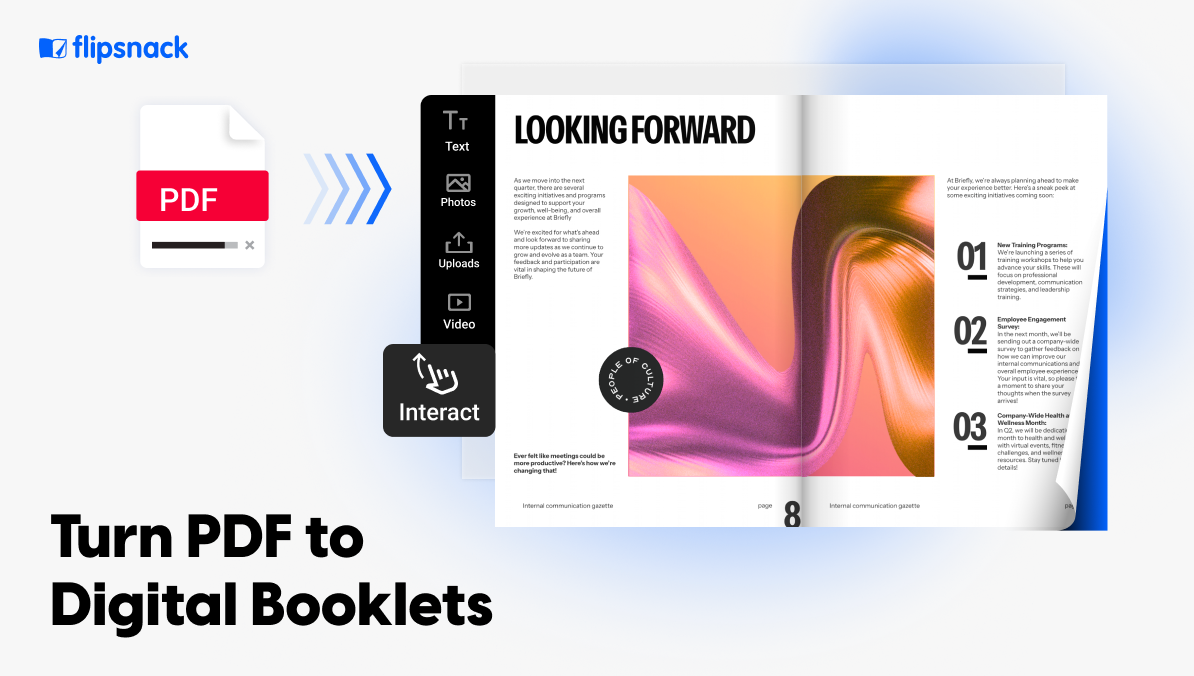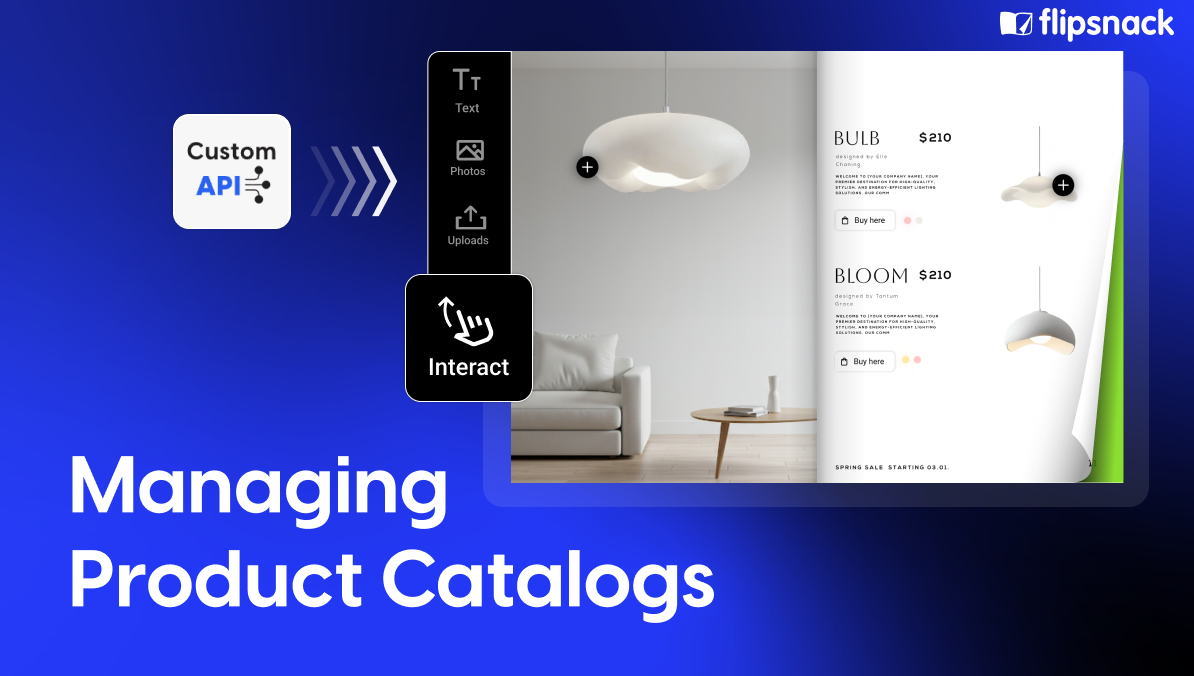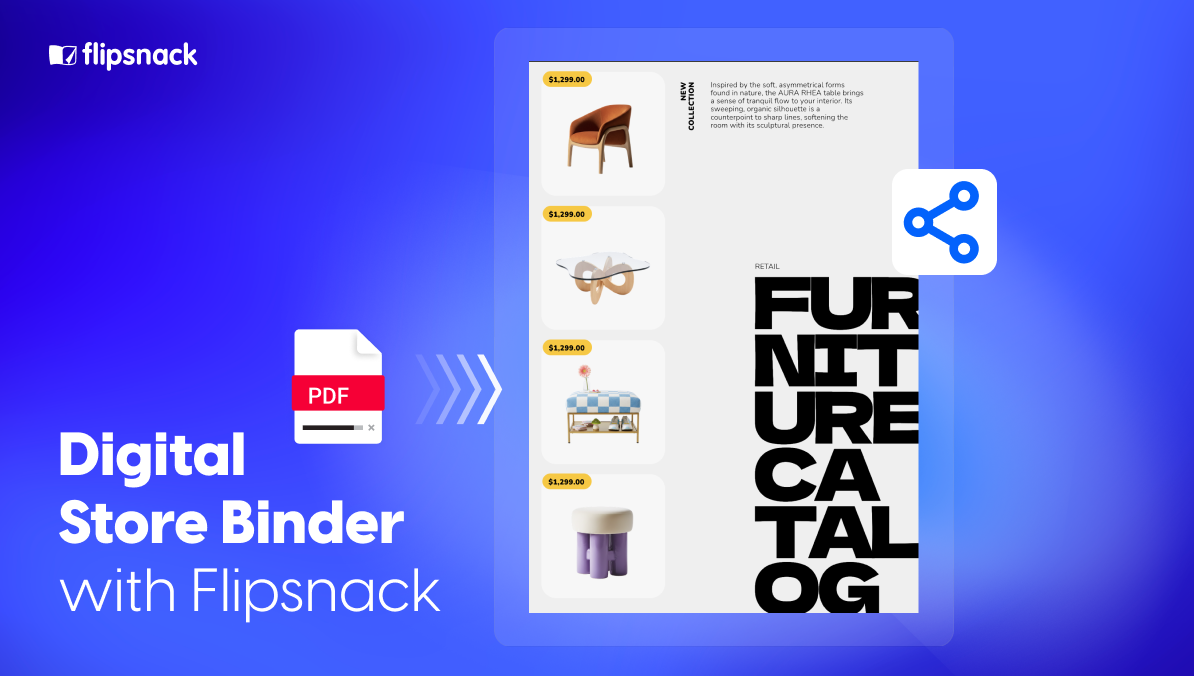How to Turn a PDF into a Booklet Using Flipsnack + Top Use Cases and Benefits
Last updated: October 24, 2025
Interactive digital booklets offer a major improvement over standard PDFs by strengthening brand awareness and encouraging audience interaction. And with the right digital booklet converter, it’s easier than ever.
This format works across teams. Marketing can publish campaign lookbooks, gated lead magnets, and event guides that capture leads and highlight calls to action. Internal communication can share handbooks, onboarding kits, and quarterly updates that people actually read and search. Retail teams can launch product catalogs that include rich visuals, pricing, and links to purchase.
In this step-by-step guide, you’ll learn exactly how to make a booklet with Flipsnack that goes beyond the limitations of static documents.
You’ll also better understand the many benefits that come with flippable booklets—like the ability to embed interactive elements, reach a wider audience, and track performance metrics.

Table of contents
- What is a digital booklet?
- Digital booklet use cases
- What are the benefits of making digital booklets with Flipsnack?
- How to make a booklet from a PDF using Flipsnack
- How to optimize your digital booklet for marketing using Flipsnack features
- Convert PDF to a digital booklet for better results
- FAQs on digital booklets
What is a digital booklet?
A digital booklet is an online version of a traditional printed booklet. It presents information in a structured, multi-page format that mimics the look and feel of a physical publication but lives entirely in digital form. Digital booklets can include interactive elements such as links, videos, and animations, making them more dynamic and engaging than their print counterparts.
They are often distributed as shareable links, embedded in websites, or sent via email, offering easy access without the costs or limitations of printing. The digital format also allows real-time updates, analytics tracking, and accessibility across devices, which adds both flexibility and reach.
Digital booklet use cases
Digital booklets have a format that allows you to divide complex topics into digestible sections while maintaining narrative flow and visual consistency.
They are ideal when you want to inform, persuade, or instruct your audience through an immersive reading experience that goes beyond plain text. You can use them for:
1. HR materials

Companies can create digital training booklets to onboard employees or explain internal procedures. They’re easy to distribute through private links or internal portals, and updates go live instantly—no need to resend files.
Embedding videos or quizzes can turn dry documentation into interactive learning resources. Engagement tracking helps HR teams see which sections employees actually read, ensuring important information doesn’t get overlooked.
2. Marketing collateral

Marketing teams rely on digital booklets to tell a cohesive brand story in a visual, interactive way. They’re effective for product launches, case studies, service guides, or campaign recaps.
Unlike static PDFs, digital booklets let you embed videos, add clickable CTAs, and integrate lead capture forms directly within the content. This turns what used to be passive reading into measurable engagement.
3. Sales enablement playbooks

Sales teams use digital booklets as living documents that keep materials current and accessible. A single booklet can include pitch decks, product specs, competitive comparisons, and objection-handling tips.
Interactive navigation helps reps find what they need quickly during calls or demos. Built-in analytics show which pages or materials prospects spend time on, so teams can refine their approach and focus on what converts
4. Higher education

Universities and colleges use digital booklets to organize and present information clearly to students, faculty, and prospective applicants. They’re ideal for creating course catalogs, research summaries, student handbooks, or admissions guides. Departments can update these materials anytime without reprinting, while embedded links, videos, and interactive navigation make academic content easier to explore.
You can create your digital booklet for any of these use cases. We’ll go through the easy process in a minute.
But first, let’s see what Flipsnack brings to the table.
What are the benefits of making digital booklets with Flipsnack?
Digital booklets provide a dynamic, interactive alternative to static PDFs that support text and images, offering a richer experience for both you and your audience. They greatly enhance the information that’s presented by incorporating multimedia elements and optimizing for online use.
Richer interactivity
Interactive booklets allow users to click, watch, and explore multimedia like videos and image galleries without leaving the document. It makes the experience much more engaging and immersive compared to more static PDFs.
Offering more interactive touchpoints, flippable booklets boost dwell time and foster deeper engagement, leading to more significant interactions with your content and company.
Easier distribution
Flippable booklets are easily shareable across platforms, including websites, social media, and email.
Their mobile-friendly design ensures that users can access your content anytime, anywhere, on any device. This allows you to reach a wider audience and provide a consistent, enjoyable experience across all platforms.
Optimized for performance and accessibility
Digital booklets made with Flipsnack are built for online performance. They load quickly, adapt to all devices, and preserve their quality on both mobile and desktop. The text layer is searchable, making content accessible to readers using screen readers.
You can also enable text selection and keyboard navigation, ensuring compliance with accessibility standards while improving user experience.
Actionable analytics
With flippable booklets, you can track how users interact with your content. Analytics provide valuable data such as page views, clicks, and time spent on each page, allowing you to identify what resonates with your audience and what needs adjustment.
These insights can help you fine-tune your content strategy for much better engagement and results.
It’s also possible to create trackable links for different audiences or channels to compare engagement and conversion.
Brand consistency
Flippable booklets allow you to maintain consistent branding by incorporating your logo, brand colors, and fonts. Doing so helps make sure that every interaction with your content reinforces your brand identity, creating a professional and trustworthy experience for your audience.
SEO benefits
Unlike static PDFs, digital booklets can be indexed by search engines. You can set titles and descriptions to optimize discoverability. Each booklet has a unique URL that can appear in search results. This helps attract organic traffic, especially for public catalogs, magazines, and brochures meant for external audiences.
Instant updates
If you need to correct a typo, update pricing, or swap visuals, you can do it directly in Flipsnack without re-sending files. The same link and embed stay active while the content updates instantly. This keeps everyone viewing the latest version.
Lead capture
Flipsnack includes a native lead form that lets you gate content and collect viewer information before full access. You can customize fields, add the form to any page, and export or sync the collected leads with tools like HubSpot, Salesforce, or Google Sheets through Zapier. Using unique trackable links lets you measure which campaigns or channels bring in the most qualified leads.
Security controls
You have multiple visibility levels—Public, Unlisted, Password-protected, or Private—to control who sees your content. You can invite specific people by email, use one-time passcodes for external viewers, or enable SSO access for internal audiences on Enterprise plans. Domain restrictions prevent unauthorized embedding, and download permissions can be turned off entirely.
How to make a booklet from a PDF using Flipsnack

Creating a digital flippable booklet from a static PDF is simple with Flipsnack. Follow these steps to turn your existing content into an interactive, engaging booklet:
Step 1: Upload your PDF
Before starting with the customization, make sure your document is in the right format. After you convert the Office file to PDF, or you make your PDF in InDesign, you can move on to the graphical part of the process, which means uploading it to Flipsnack.
Once you log into Flipsnack, go to Create → Upload PDF and choose the file from your device or Google Drive. Flipsnack will automatically convert your PDF to a booklet with a realistic page-flip effect that helps keep readers drawn in.
Step 2: Customize your booklet’s appearance
Next, it’s time to make the digital booklet your own. Customize the look and feel by adding your brand’s logo, adjusting the colors, and selecting fonts that align with your brand identity. Doing so helps create a cohesive, branded experience for your audience.
Step 3: Add interactive elements
One of the biggest advantages of digital booklets is the ability to add interactive features. You can embed videos, insert clickable links to external websites, or create image slideshows.
These elements transform a simple PDF into a more engaging and user-friendly document that captures attention and encourages interaction.
Step 4: Control visibility and sharing options
Once your digital booklet is ready, you can decide how it will be shared and who will have access to it. You can choose to make your digital booklet public and share it via link, email, on social media, or as a QR code.
If you need to share it only with a few people or inside your company, you can choose to share it via private links, keep it unlisted, or even password-protect it, giving you full control over who can view your content.
Step 5: Publish and track performance
Once published, you can monitor how your audience interacts with the booklet. Flipsnack offers statistics tools that track impressions & views, average time spent reading your booklet, downloads, source, location, page-level statistics, and engagement with interactive elements.
You can also connect Google Analytics with your Flipsnack profile for even more in-depth statistics.

How to optimize your digital booklet for marketing using Flipsnack features
Digital booklets aren’t just about delivering content—they can be powerful tools for driving your organization’s marketing efforts.
Boost lead generation with engagement interactions
Interactive features like embedded lead capture forms, surveys, or calls-to-action can turn your booklet into a direct source of leads. These elements encourage users to engage more deeply and provide their information without leaving the document, streamlining the lead generation process.
Flipsnack lets you add a lead form to any page and choose whether viewers can skip it or not.
Utilize embedded links for direct purchases
Digital booklets can easily integrate eCommerce functionality by embedding links to product pages. You can also allow clients to create shopping lists they can send directly to you via email or WhatsApp.
This enables customers to explore and buy directly from the booklet, transforming it into a dynamic sales tool that drives conversions.
Customize for SEO
To increase your booklet’s online visibility, try to optimize it with searchable titles. Moreover, once you finish designing your booklet in Flipsnack, you have the option to add a title and a description in the Overview section.
This makes your booklet easily discoverable through search engines, helping you reach a broader audience and attract more potential customers.
Convert PDF to a digital booklet for better results
With the ability to embed multimedia, track user engagement, and share content seamlessly across platforms, digital booklets provide a powerful solution for businesses. Make a booklet with Flipsnack and change the way you present content to your audience.

FAQs on digital booklets
A PDF is a static document format, while a digital booklet is an interactive publication you can view and share online. With a tool like Flipsnack, you can turn a regular PDF into a dynamic booklet that includes videos, links, animations, and analytics. This makes digital booklets more engaging and measurable than standard PDFs.
Yes. In Flipsnack, you can edit your booklet anytime—fix a typo, change an image, or update pricing—and the same shared link will display the new version. There’s no need to resend files or replace embeds, which makes content maintenance fast and efficient.
Absolutely. Flipsnack booklets are responsive and optimized for all screens, including phones and tablets. Text remains legible, pages flip smoothly, and interactive features like links or videos work just as they do on desktop, ensuring a consistent reading experience everywhere.
Yes. If your original content started as a PDF and needs to be used for accounting or financial purposes, it can be converted to QBO (QuickBooks Online format) using conversion software. The QBO file type is built for financial data, allowing easy imports into accounting platforms. While this process isn’t part of creating digital booklets, it’s helpful when your files include business or transaction records.




